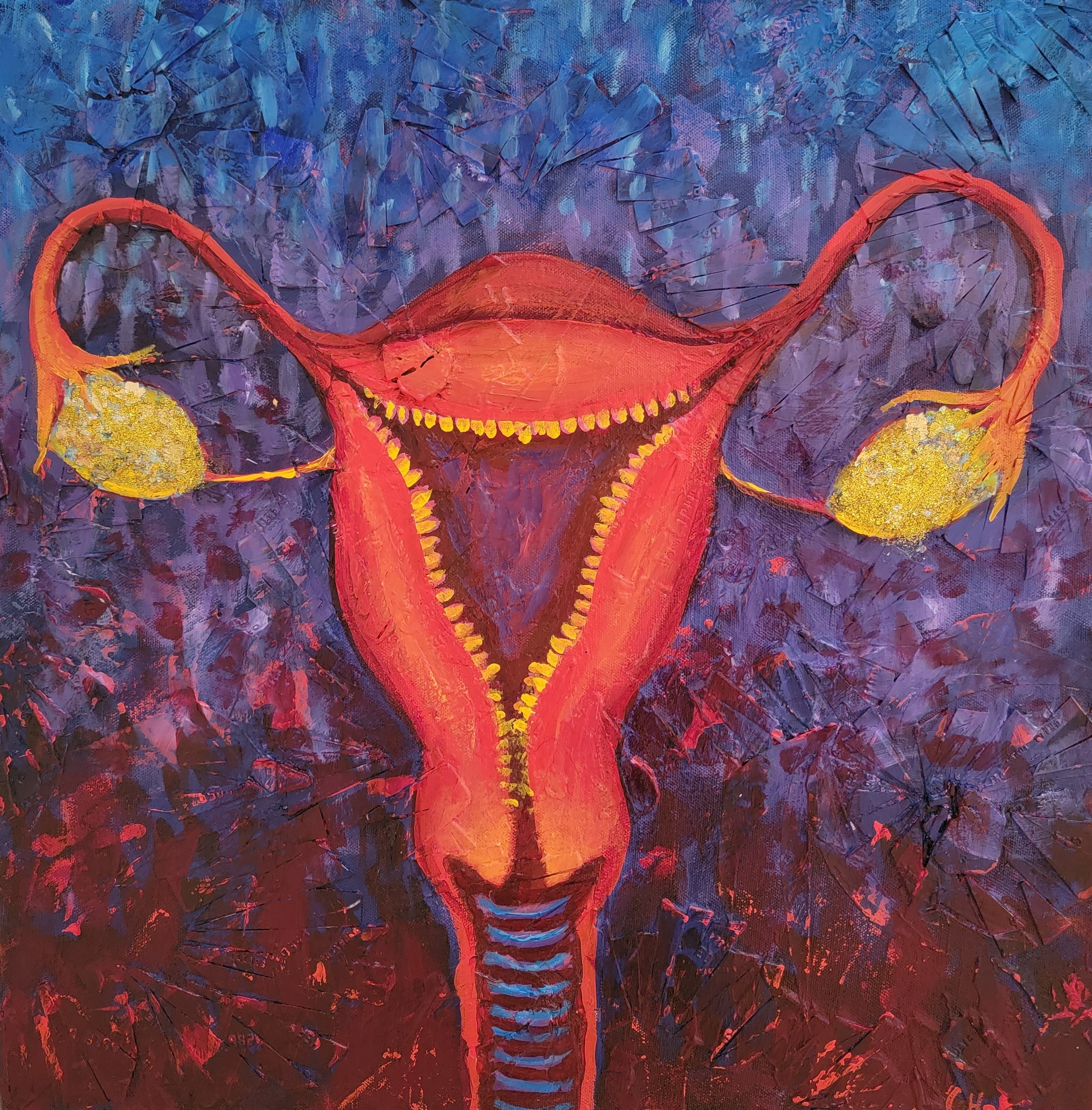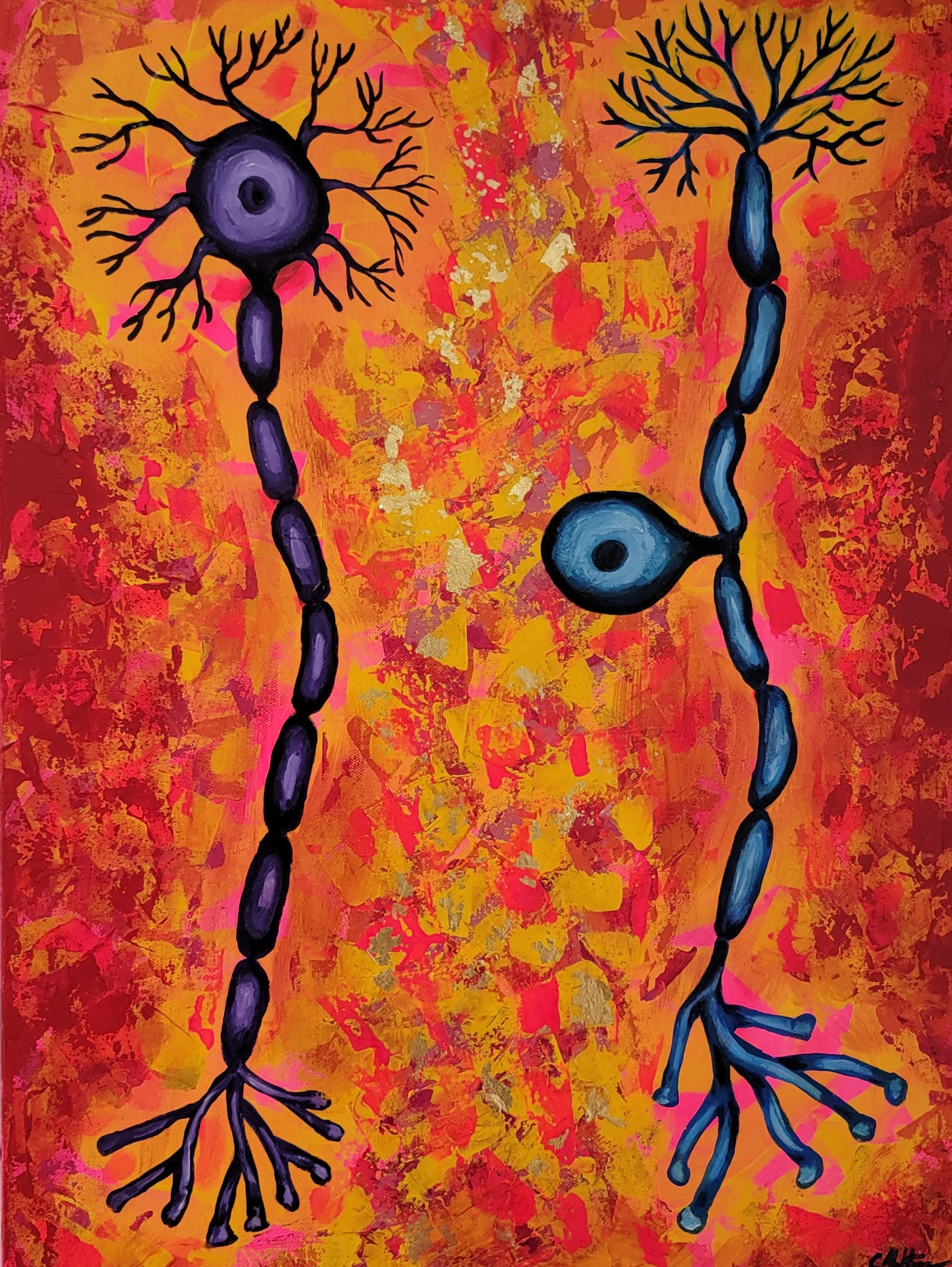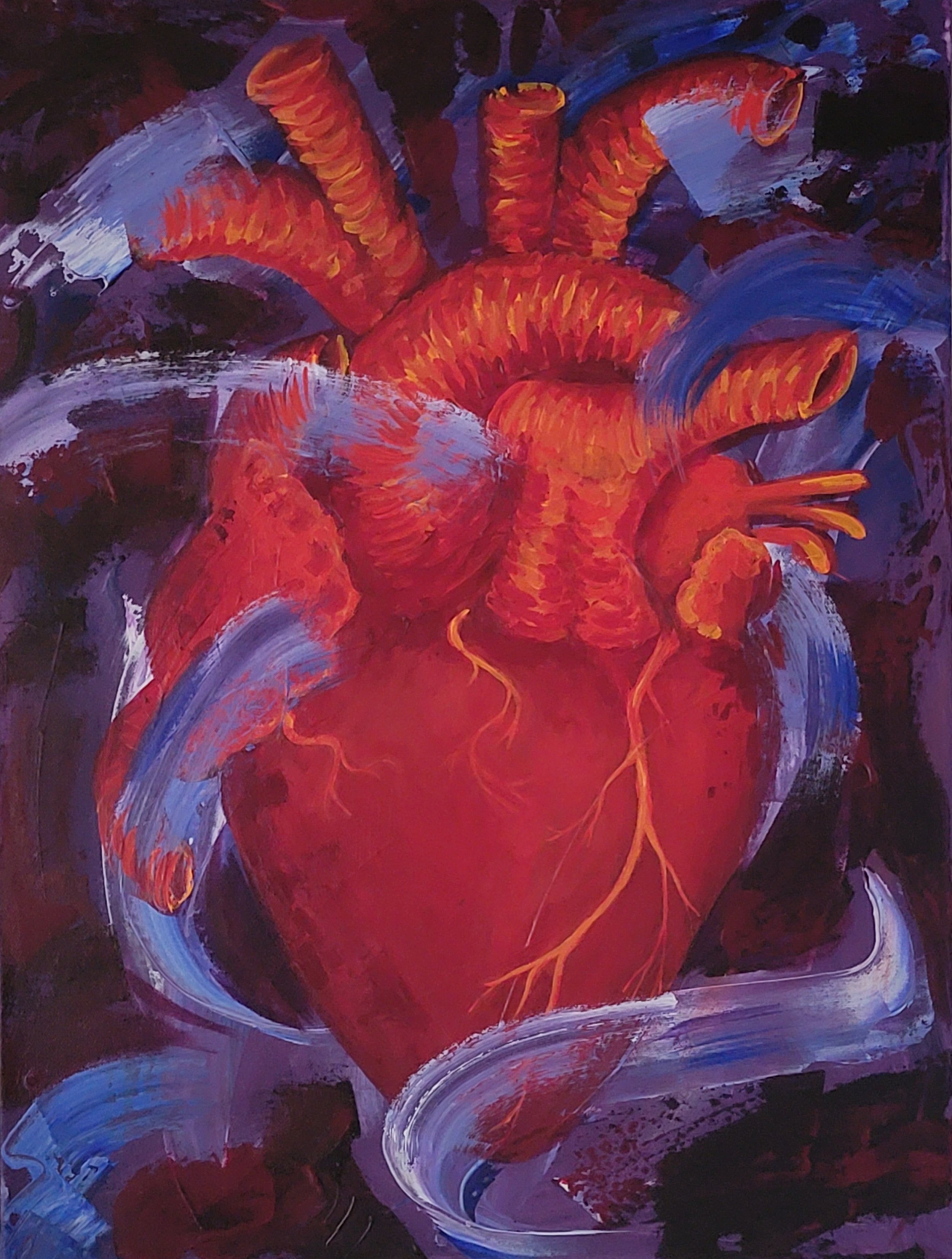The Corpus Chromatic Series
The Corpus Chromatic series is a body of portraits meant to celebrate and venerate living human systems for their physical beauty, unique functions, characteristics, ancient designs, and meaning. Anatomical subjects are abstracted with bright colors to bring attention to them and to add fantasy, drawing attention to the beauty and function of the living object itself. The fragility of the human body with all its intricate systems and delicate parts is sometimes feeble, fracturable and weak. Likewise, the resiliency of the body is compelling with its ability to recover from illness and injury. The depiction of human anatomy in my artwork comes from an awareness of radical aliveness, a sense that we can participate in healing our bodies and shift negative trajectories under any conditions.
Corpus Chromatic, on exhibition in The Louise Jones Brown Gallery, Duke University, Nov 12-2021 - Jan 15, 2022
The Anatomy of Breath, 10”x10” 2021
The interconnectedness of the heart and lungs: The pulmonary artery is a big artery that comes from the heart. It splits into two main branches, and brings blood from the heart to the lungs. At the lungs, the blood picks up oxygen and drops off carbon dioxide. The blood then returns to the heart through the pulmonary veins.
Unhurt, 36”x36”, 2021
The heart is at the center of the circulation system, pumping blood around the body as the heart beats. This blood sends oxygen and nutrients to all parts of the body, carrying away unwanted carbon dioxide and waste products. The loose splashes of color resemble a bloody wound as a clichéd expression of torment in love. The scale and texture of the subject show its power and strength along with the splashy display of injury.
SOLD
The Regulator (Thyroid) 10”x10”, 2021
Kidney 10”x10” 2021
The Light (for Dalia) 24:x24” 2020
Love Machine, 2021
Filter (to my Liver) 2021
The liver cleans up all the body's toxins and filters them out of the blood, allowing potentially harmful unnecessary substances to be removed. This unusual view of this organ shows the gallbladder and part of the intestines, depicted with embellished veins and flowy lines to show activity.
Lymph Node Dragonflies 2021, From Sketchbook
The Enduring Tree, 24”x36” 2020-21
This is the last tree standing in a logged field near my home. Its form shows starkly on the winter's night and its branches are designed for effective collection and distribution of resources In any season. This tree is a place of Spirit, bringing thoughts of indigenous people who once lived at that place.
Sacred geometric patterns and symmetry exist all around us, creating the fundamental structure and templates of life in the universe.
Christening, 12”x16” 2021
The thyroid gland is located at the front of the neck just below the Adam's apple , or larynx. It is butterfly-shaped and consists of two lobes located either side of the windpipe, or trachea. The thyroid gland produces hormones that regulate the body's metabolic rate controlling heart, muscle and digestive function, brain development and bone maintenance. The submerged thyroid organ is in the process of healing as it is awash in a baptismal observance.
Expanse, 11”x14” 2021
A study of scale and surrealism
Alert, Awake and Alive, 18”x24” 2020
SOLD
The Sound of Silence, 2021
The cochlea is the auditory area of the inner ear that changes sound waves into nerve signals. Here the subject is celebrated for its physical form, a quality of this organ which is not universally recognized. The cochlea, with its delicate canals and forms, is featured floating over a deep and vast landscape.
SOLD
Perception, 2021
The eye is a sensory organ, collecting light from the visible world around us and converting it into nerve impulses. The optic nerve transmits these signals to the brain, which forms an image thereby providing sight.
This diagram shows details of a human eye, and also hints at an aerial view of an imagined place
Translation (Listening) 2021
The human ear is an organ of auditory perception and equilibrium that detects and analyzes sound by transduction, the conversion of sound waves into electrochemical impulses, and maintains the sense of balance. The folds of the outer ear are delicate and intricate, and can resemble the shapes of seashells or flower petals. This is the artist's ear, illustrated in golden hues and textured brushstrokes, a visual representation of listening in conversation, a struggle to communicate and the vibrations received through the ear canal.
Larynx 2021
The larynx, also commonly called the voice box or glottis, is the passageway for air between the pharynx above and the trachea below. The larynx plays an essential role in human verbal communication; during sound production, the vocal cords close together and vibrate as air expelled from the lungs passes between them. This physical organ is given a lustrous glow for reverence at how magical it can feel to make sounds.
Lymph Dance 2021
Lymph nodes filter substances that travel through the lymphatic fluid, and they contain lymphocytes (white blood cells) that help the body fight infection and disease. This bright, healthy and sinuous formation floats over a colorful background of blues, inspiring the sea or sky.
Staying the Course 2021
The liver is essential for digesting food and ridding your body of toxic substances. The stomach secretes acid and enzymes that digest food.The purpose of the large intestine is to absorb water and salts from the material that has not been digested as food, and get rid of any waste products left over. By the time food mixed with digestive juices reaches your large intestine, most digestion and absorption has already taken place.This short section is the part of the small intestine that takes in semi-digested food from your stomach through the pylorus, and continues the digestion process. The duodenum also uses bile from your gallbladder, liver, and pancreas to help digest food. The butterfly in the stomach is a visual reference to the cliché "butterflies in the stomach" referring to anxiety or nervousness. Highlighting this feeling contrasts with the involuntary function of a healthy digestive system.
Dissection (Anatomy of a Lymph Node)
Lymphadenectomy is a surgical procedure in which the lymph nodes are dissected and a sample of tissue is checked for the presence of malignancy under the microscope. It is an operation usually performed as part of the surgical management of malignant tumors. The anatomy of a lymph node is mysterious and not commonly known, though only through a pathology exploration are these secrets revealed. Losing loved ones due to lymphoma created a personal inquiry and exploration into the function, anatomy and treatment of lymphatic cancer. This illustration is a depiction of a healthy lymph node.
The Width of My Love, 2021
The pelvis plays important functions in locomotion, as body weight is transmitted to the lower limbs through the pelvic girdle, childbirth, as the human neonate must pass through the birth canal, which lies within the pelvic girdle as the baby exits the body, and support of abdominal organs which are held up by both the pelvic floor musculature and the pelvis itself. Viewing the width and depth of hips and belly as a burden, the desire to become smaller and take up less physical space is familiar in American culture. Here the pelvis is fully acclaimed with bright pink hues and on a large 4’x4’ scale.
Tracheobronchial Tree 2021
The lower respiratory tract is called the tracheobronchial tree, describing the branching structure of airways supplying air to the lungs. It includes the trachea, bronchi and bronchioles. At each division point or generation, one airway branches into two or smaller airways. These branching forms, so much like the venation of tree limbs or leaf veins, also distribute material more efficiently from one location to another.
Voicebox 36”x36” 2021
The larynx, or voice box, is located in the neck and is involved in swallowing, breathing, and voice production. Sound is produced when the air which passes through the vocal cords causes them to vibrate and create sound waves in the pharynx, nose and mouth. The view illustrated here is a vertical perspective, as if looking down the throat from up above the head. The form is both familiar and illusive, suggesting other anatomy in the human body.
Legacy (Uterus, Ovaries and Fallopian Tubes) Mixed media, currency and credit cards on canvas
The question of what we leave behind can be especially fraught for people who do not have children. In this piece, materials of personal financial wealth are used to fashion female reproductive organs, generally considered the most commonly named, enduring way to leave a legacy. There are existential implications of not having offspring, which can drive the search for meaning and lasting impact in a life, while financial endowments and the passing of heirlooms can for some supplant this.
Neuron Dance
These neurons are the cells responsible for receiving sensory input from the external world; for sending motor commands to our muscles, and for transforming and relaying the electrical signals at every step in between. Such connections between sensory and motor neurons underlie motor reflex loops and several forms of involuntary behavior, including pain avoidance. The neuron on the left is a motor neuron whose cell body is located in the motor cortex, brainstem or the spinal cord, and whose axon (fiber) projects to the spinal cord or outside of the spinal cord to directly or indirectly control effector organs, mainly muscles and glands. The sensory neuron (on the right) are neurons in the nervous system that convert a specific type of stimulus, via their receptors, into actions or impulses.
Thank you, friend. Me too.
Stay tuned!!
And Now, New Work Since January 2022
Divine Autonomy 24”x36”
The brain stem is responsible for regulating most of the body’s automatic functions that are essential for life, including breathing, heart rate, sleep cycle and body temperature. The Halo has become representative of divinity, supreme power, and sacredness and is depicted with gold leaf to give light to it. The practice of using the Halo as a symbol is the common cultural practice of identifying the divine beings or objects with the Sun.
Home at the Sea 24”x36”
The sacrum is a large triangle-shaped vertebra at the lower end of the spine. It is created when the sacral vertebrae fuse between the ages of 18 and 30. The sacrum forms the pelvis by joining with the hip bones, which gives the spine a strong base of support. At the top, it joins with the lumbar vertebrae to form the lumbosacral joint. At the bottom, it connects with the coccyx retail bone to form the sacrococcygeal joint. It also links with the ileum on the right and left sides to form the sacroiliac joint. The female sacrum is shorter and wider to allow for childbirth. The sacral bone is very sturdy as it is responsible for supporting the entire weight of the body. Many important muscles that facilitate leg motion originate on the sacral surface. The sacrum also acts as a protective shield, enclosing the nerves of the lower back.
This floating sacrum, barely touching the water’s surface, creates a ripple which brings to mind a sense of rooting and grounding and represents connection to water as from our original creation space in the womb.
Safe Passage 12”x36”
The esophagus is a muscular tube connecting the throat (pharynx) with the stomach. It is about 8 inches long, and is lined by moist pink tissue called mucosa. The esophagus runs behind the windpipe (trachea) and heart, and in front of the spine. Just before entering the stomach, the esophagus passes through the diaphragm. The upper esophageal sphincter is a bundle of muscles at the top of the esophagus. The muscles of the UES are under conscious control, used when breathing, eating, and vomiting. They keep food and secretions from going down the windpipe. The lower esophageal sphincter is a bundle of muscles at the low end of the esophagus, where it meets the stomach. When the LES is closed, it prevents acid and stomach contents from traveling backwards from the stomach. These LES muscles are not under voluntary control. I painted a beautiful, healthy esophagus to celebrate my personal healing from years of eating disordered behaviors and to show how joyful it can feel to swallow and enjoy delicious food, nourishing my body..
Safe Passage
Hearth 24”x24” This hearth was discovered in the woods off a trail by the Eno River in Durham, NC. It remind me of what remains within our physical and emotional selves when we experience grief and loss with changing geographical locations, the end of personal relationships and death. The heart remains a symbol of effervescent life and breath as life cycles change and events occur to cause physical, spiritual and emotional displacement.
The actual chimney hearth in the woods, Eno River State Park, Durham, NC 2022
Emotere (Energy in Motion)
The crown chakra is all about spiritual connection and transformation. It lifts and inspires, and also gives us a sense of our own divinity, the awareness that each of us is a soul in a human body. This was created after a session of energy work focusing on balancing the Crown chakra, helping to move through feeling stuck in strong negative patterns of thinking..













































